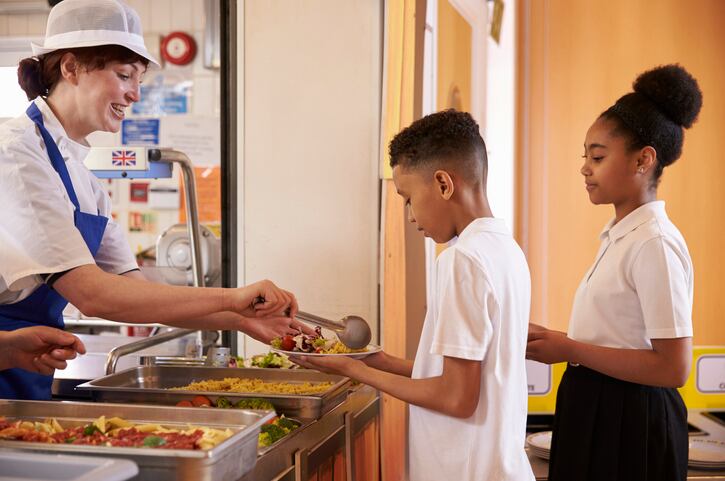Since the coronavirus pandemic was declared just over a month ago, 48 states and the District of Columbia have closed schools to help slow the spread of the virus, but in doing so approximately 30 million low-income children have lost access to free or reduced-price school meals through the school lunch or breakfast program, explained Sara Bleich, a professor of public health policy at the Harvard Chan School of Public Health.
This loss weighs heavily on children living in low-income households, for whom school meals account for up to two-thirds of their daily nutrition needs, she added during a press call coordinated April 22 by the Robert Wood Johnson Foundations’ national Healthy Eating Research program.
She also noted that while many schools are “doing amazing things to provide nutritious meals to students under these pandemic conditions,” and the government has taken steps to address this access gap, these measures are falling short.
Schools need more funds, personal protective equipment
For example, Bleich said, many schools are struggling to identify how best to provide meals to children, protect the safety of food service staff and balance the extra costs associated with pandemic response.
She explained, one way that the US Department of Agriculture has tried to ease food insecurity for school children is to grant permission for schools to use approaches for the Summer Feeding Program to help provide meals to children in need during the COVID-19 closures.
However, Bleich argued, this strategy has fallen short in part because, “many schools lack experience with summer feeding activities since they only reach about one in seven children who usually receive free or reduced-price school meals during the year.”
Schools that have successfully navigated this program or found other ways to provide meals to children are faced with additional challenges, including an inability to sufficiently protect workers, she said.
“Many food service staff are worried about their safety when they go to work, and some feeding cities have opted to close because of staff getting COVID-19,” Bleich said.
She acknowledged, that the recently passed Coronavirus Aid, Relief and Economic Security (CARES) Act provided money for schools to purchase cleaning and sanitation supplies, which can include personal protective equipment for food services workers, “but more help is needed in this area.”
Schools that are providing meals during the pandemic also are struggling with additional expenses that are not fully covered by reimbursement for meal service, Bleich said. She explained that many school districts across the country are facing higher expenses than normal, such as the need to bus meals to children who can not travel to an access site.
At the same time that they are facing higher costs, many are seeing a decrease in revenue from reduced meal participation, she added.
As such, she advocated any future relief legislation should include funding to cover costs incurred by school nutrition programs during the pandemic response, and resources for additional personal protective equipment.
Increased SNAP benefits needed
In addition to providing more aid to school nutrition programs, Bleich argues the government must increase the benefits under the Supplemental Nutrition Assistance Program beyond what it already has increased.
“Increasing the size of the SNAP benefit is a proven policy approach to stimulate the economy, reduce the economic hardship and improve health,” she argued.
She explained that current SNAP benefit levels are insufficient for most participants to acquire nutritious food throughout the month, with many running out before the month’s end. To address this, she said, many advocates and some members of Congress are calling for a 15% increase in the maximum SNAP benefits, which is equivalent to about $100 per person, per month for a family of four.
This would be in addition to a provision in the Family First Act that gave states an option to request a waiver for pandemic EBT equivalent to about $114 per month per child who received free or reduced priced meals at school to offset the cost of the additional meals served at home. While this money would help, Bleich noted, as of April 18, only six states have been approved to offer pandemic EBT and at least three other states have requested the waiver but have not yet been approved.
The Family First Act also included an option for states to request a waiver to provide emergency benefits for all SNAP households up to the maximum monthly allotment. And while USDA announced April 22 that all states had received this waiver, Bleich noted that 40% of households on SNAP already receive the maximum benefit, which means 1.9m families with children are not eligible for this emergency benefit.
The requested increase in SNAP benefits would also be in addition to the $15.8b allotted under the CARES Act for anticipated shortages in SNAP administrative and benefit costs related to increased enrollment associated with rising unemployment.
“Unemployment has been skyrocketing and roughly 14% of the workforce filed for unemployment in less than a month, and so millions of Americans are expected to turn to SNAP – many for the first time,” Bleich said.
Overall, she concluded, while the federal government has lowered hurdles and increased access to funds to help feed children already, “in order to sustain these essential feeding programs, adding more funds is going to be really important.”




